
Author: Grumpy
Now I am always amazed at the following facts. That all US Marines have two Birthdays. That & The Marine Corps was born in a Tavern. But I guess that is just the way it is.
So….
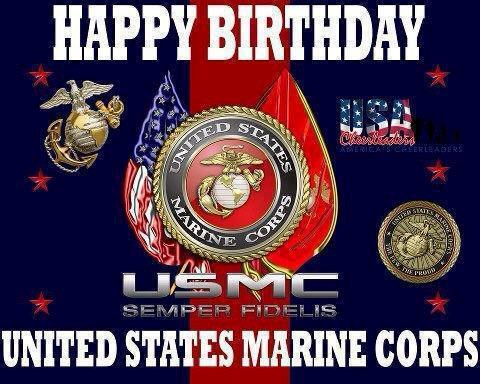
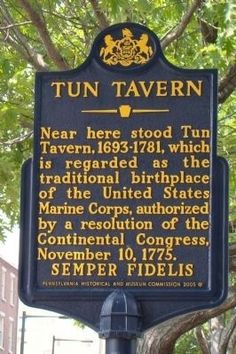

Yeah I just could not resist it!

Garry Owen!
Guess what I just bought today!
Thanks for the great deal at Gunrunners in Duarte Calif!




Smith & Wesson Model 15
| Smith & Wesson Model 15 | |
|---|---|

Smith & Wesson Model 15
|
|
| Type | Revolver |
| Place of origin | United States |
| Specifications | |
| Cartridge | .38 Special |
| Feed system | 6-round cylinder |
The Smith & Wesson K-38 Combat Masterpiece, Revolver Model 15 is a six-shot double-action revolver, with adjustable open sights, built on the medium-size “K” frame.
It is chambered for the .38 Special cartridge and is fitted with a 4-inch (100 mm) barrel, though additional barrel options have been offered at various times during its production. Originally known as the “K-38 Combat Masterpiece”.
It was renamed the Model 15 in 1957 when all Smith & Wesson revolvers were given numerical model numbers. It is a shorter barrel version of the Smith & Wesson Model 14 Target Masterpiece and essentially an adjustable-sight version of the seminal Smith & Wesson Model 10 (“Military and Police”) revolver with target shooting features.
The main production run of the Model 15 was from 1949 through 1999. It was discontinued for approximately a decade until 2011, when a re-tooled version was re-released under S&W’s Classics Revolvers line.
Contents
[hide]
History[edit]
The Smith & Wesson K-38 Combat Masterpiece Revolver Model 15[1] is a derivative of the classic 1899 K-frame (medium frame) Military and Police .38 S&W Special (aka .38 Special) six-shot double-action revolver. The M&P underwent steady evolution throughout the 20th century and S&W spun off several variations as separate models in the post World War II years. One of these was the K-38 Target Masterpiece, which began production in 1947. The Target Masterpiece included a number of new and/or special features, including a six-inch barrel with a narrow rib to provide a level sight plane, a Partridge front sight, a micrometer click rear sight, S&W’s .375” short-throw hammer, a trigger adjustment for overtravel, and improved grips.[2] Noting the accuracy of the Target Masterpiece, a number of police departments and the FBI soon requested the same revolver with a four-inch barrel and a Baughman Quick Draw front sight. The result was the K-38 Combat Masterpiece. The major distinction between the K-38 Target Masterpiece and the K-38 Combat Masterpiece is the barrel length and the front sight.[2]
In 1957 the K-38 Combat Masterpiece was renamed the Model 15 when all Smith & Wesson revolvers were given numerical model numbers. (The Military & Police and the Target Masterpiece were renamed the Model 10 and Model 14 respectively.) The model number is stamped on the frame behind the cylinder yoke, so it is visible (only) when the cylinder is open. A number of production and engineering changes have been made throughout the years, some of which are noted by a dash number suffixed to the Model number (15-1, -2, -3).
Over the years the Model 15 has been produced with several barrel lengths, with 4″ (standard) and 2″ (1964–1988) being the most common. In 1972 S&W released a stainless steel version as the Model 67. In 1997 the hammer and internal lockworks were modified from an on-the-hammer firing pin / internal hammer block to a floating firing pin / MIM flat hammer, and kept the hammer block that, unlike a transfer bar safety design, moves up with the trigger pull. The hammer hits a transfer bar, transferring the strike to the firing pin, while the block in a hammer block system moves down with the trigger pull, unblocking the hammer from the firing pin, allowing the hammer to strike the firing pin. These two safety systems work oppositely, but achieve the same goal of only allowing the gun to fire when the trigger is pulled all the way.
The Model 15 was a popular sidearm for law enforcement and was the standard issue sidearm of the U.S. Air Force Policefrom 1962 until 1992 when it was replaced by the Beretta M9 pistol.[citation needed]
Production of the Model 15 was discontinued in 1999 when Smith & Wesson was purchased and reorganized, although a couple limited run “Heritage Series” models were released in 2001 and 2002. In 2011 Smith & Wesson re-introduced the Model 15 (15-10) under their Classics Revolvers line, newly machined, with a shrouded redesigned barrel, and a built-in trigger lock (located just above the cylinder release thumbpiece on the left side).[2]
Specifications[edit]
- Caliber: .38 S&W Special
- Capacity: 6
- Barrel: 4” (standard configuration)
- Length overall: 9 1/8” With 4” barrel
- Weight loaded: 34 oz. With 4” barrel
- Sights: Front – 1/8” Baughman Quick Draw on plain ramp. Rear: S&W Micrometer Click Sight, adjustable for windage and elevation.
- Frame: square butt with grooved tangs
- Stocks: checked walnut service with S&W monograms
- Finish: S&W blued carbon steel with sandblasting and serrations around sighting area to break up light reflections
- Trigger: S&W grooving with adjustable trigger stop
- Ammunition: .38 S&W Special, .38 S&W Special Mid Range, .38 + p
Engineering and production changes timeline[edit]
| Smith & Wesson Model 15-2 | |
|---|---|
 |
As the K-38 Combat Masterpiece Revolver Model 15 evolved the following engineering and production changes were made:[2]
- 1949: K-38 Combat Masterpiece introduced
- 1955: Delete upper sideplate screw
- 15 (1957): K-38 Combat Masterpiece continued as the Model 15; stamping of model number
- 15-1 (1959): Change extractor rod, right hand to left hand thread
- 15-2 (1961): Delete trigger guard screw, change cylinder stop
- 1964: Introduce 2” heavy barrel
- 15-3 (1967): Relocation of rear sight leaf screw
- 1968: Delete diamond grips
- 15-4 (1977): Change to put gas ring from yoke to cylinder; pinned barrel eliminated
- 15-5 (1982)
- 1986: Introduction of 6” and 8-3/8” barrel
- 15-6 (1988): New yoke retention system/ radius stud package/hammer nose bushing
- 1988: Discontinue 8-3/8” and 2” barrel
- 1992: Discontinue 6” barrel, blue finish only
- 15-7 (1994): Synthetic grips introduced, drill and tap frame, change rear seat leaf, change extractor
- 1995-96: Delete square butt
- 1996: Begin shipments in blue plastic case
- 1997: 4” barrel only; change to MIM thumbpiece; shipped with master trigger locks; change to MIM trigger
- 15-8 (1997): Changes in frame design: cylinder stop stud eliminated; eliminate serrated tangs; change to MIM hammer with floating firing pin and change internal lockworks
- 1999: Model 15 discontinued in November
- 2001: Limited run Lew Horton Heritage Series from the S&W Performance Center.
- 15-9 (2002): Limited run Lew Horton Heritage Series McGivern Models from the S&W Performance Center. 3 Models commemorating Ed McGivern’s world speed records in 1934 with a revolver. All models have a Patridge front sight with Gold Bead, round butt frame with Altamount Fancy checkered service grips of that era, 6” barrel, Ed McGivern commemorative plate mounted on right side of frame, Heritage Series box.
- 15-10 (2011): Production re-commenced under Classics Revolvers line, re-tooled, shrouded redesigned barrel, internal trigger lock
Military and police usage[edit]
As the “K-38 Combat Masterpiece”, this revolver was first purchased in 1956 for the Strategic Air Command Elite Guard of the United States Air Force. From 1960 to 1969 the Air Force bought large numbers of Model 15-1, 15-2, and 15-3 revolvers with a 4″ barrel. The only distinctive markings are “U.S.A.F” on the left side of the frame. Originally all were blued, though some were reparkerized while in Air Force service.[2] The Model 15 was the standard issue sidearm of the U.S. Air Force Air/Security Police from 1962 until 1992. It was issued to security personnel in other branches of the U.S. armed forces, including the Naval Security Forces.[2]
The Air Force issued two types of .38 Special duty ammunition for the Model 15, originally the M41 .38 Special Ball (full metal jacket) cartridge, or the later-developed Caliber .38 Special, Ball, PGU-12/B High Velocity cartridge. The M41 was a low pressure cartridge rated at 13,000 psi, originally designed for 158-grain ball ammunition, but loaded with a 130-grain FMJ bullet. The PGU-12/B, issued only by the U.S. Air Force, had a greatly increased maximum allowable pressure rating of 20,000 psi, sufficient to propel the 130-grain FMJ bullet at 1,125 ft/s (343 m/s) from a solid 6-inch (150 mm) test barrel, and 950–980 ft/s (290–300 m/s) from a 4-inch (100 mm) revolver barrel.[4]
The S&W Model 15 revolvers were replaced by the Beretta M9 pistol in 9×19mm caliber beginning in 1985, with complete turnover by the early 1990s.[2]
In addition to military use, the Model 15 was issued by many police departments across the United States as well as various federal law enforcement agencies.[2] In 1972 S&W produced a stainless steel version of the Model 15 which it termed the Model 67.[2]
Users[edit]
The LAPD’s Model 15 revolvers (and department issued Model 36 5-shot, 2-inch barrelled snub nose Smith & Wesson revolvers for detectives, plainclothes, undercover and other officers’ off duty carry) were modified to be fired double-action only. This was accomplished by the department armorer who ground the full cock notch from the hammers. Officers were then trained to shoot combat style without ever cocking the weapons. This change was likely the result of unintended injuries and/or property damage, and of litigation against the LAPD after officers had cocked their weapons only to have them discharge inadvertently, possibly as a result of physical attacks or having been startled in the course of searching for suspects. In lawsuits, the principle of res ipsa loquitur was easily affirmed because “an inadvertent weapon discharge is a negligent discharge”.[2]
Overland Park Police Department (Kansas) used the revolver before going to semi-automatic Beretta 92 pistols.
See also[edit]
- The Model 10 Military & Police (cornerstone of the S&W .38 Special line of revolvers)
- The Model 14 Target Masterpiece (6″ barrel predecessor to the Model 15)
- The Model 18 Combat Masterpiece (.22 caliber version of the Model 15)
- The Model 19 Combat Magnum (.357 magnum version of the model 15)
- The Model 67 and Model 68, stainless steel versions of the Model 15
Welcome!

Why are there so many tree-lined roads in France?
Because German soldiers prefer to march in the shade.
———————————————
What did the Mayor of Paris say to the German General?
Table for 100,000? No problem Monsieur!







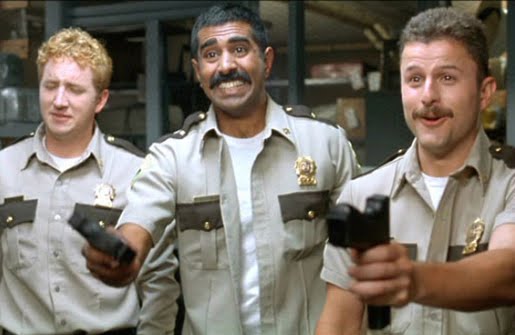


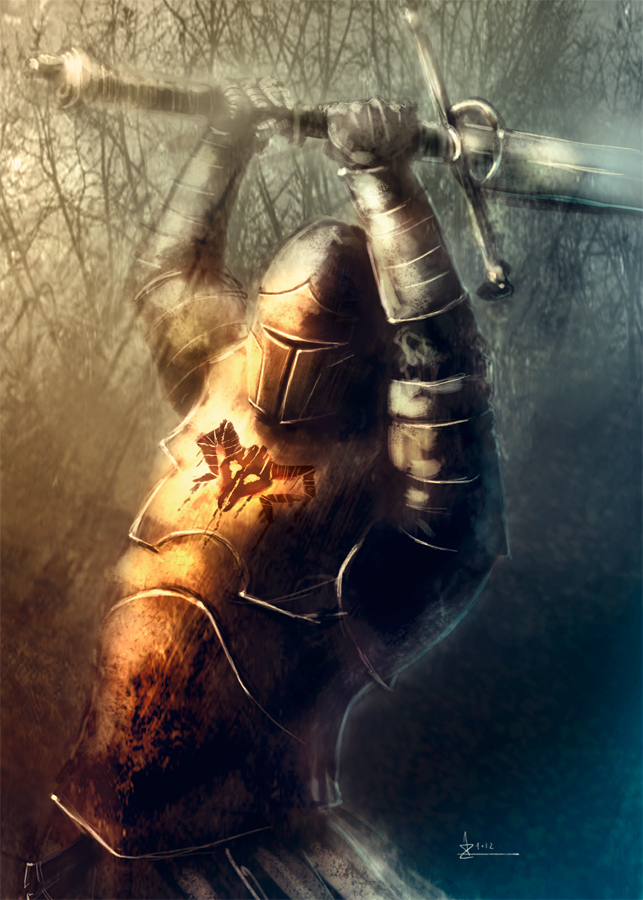

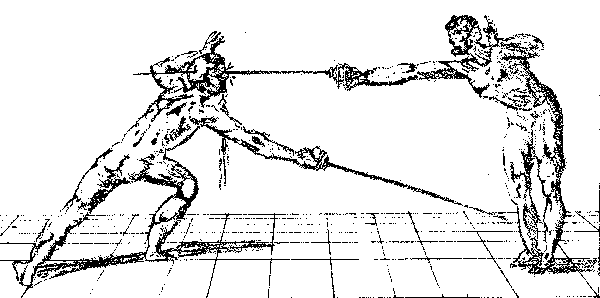
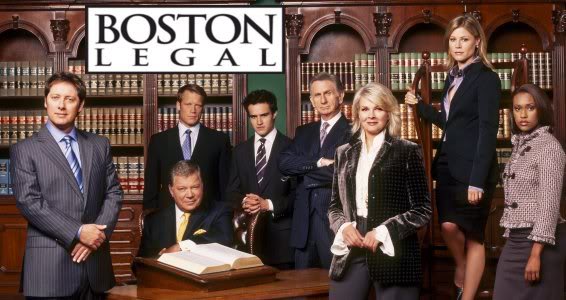
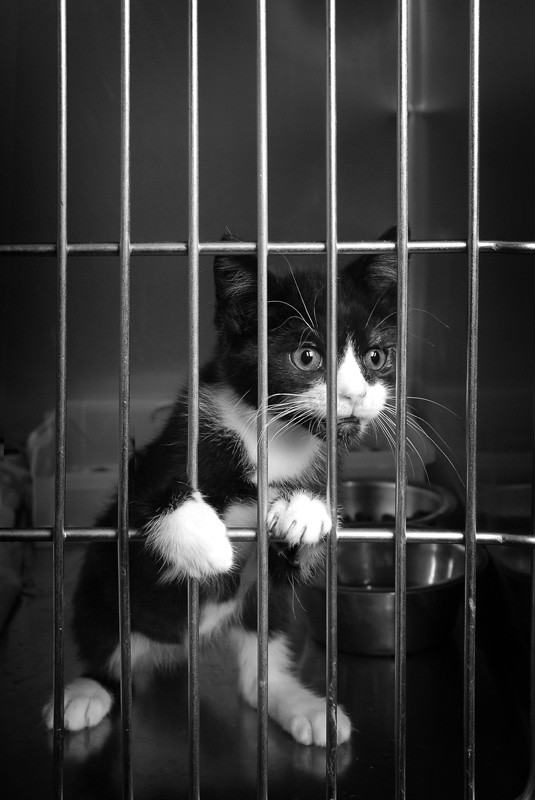

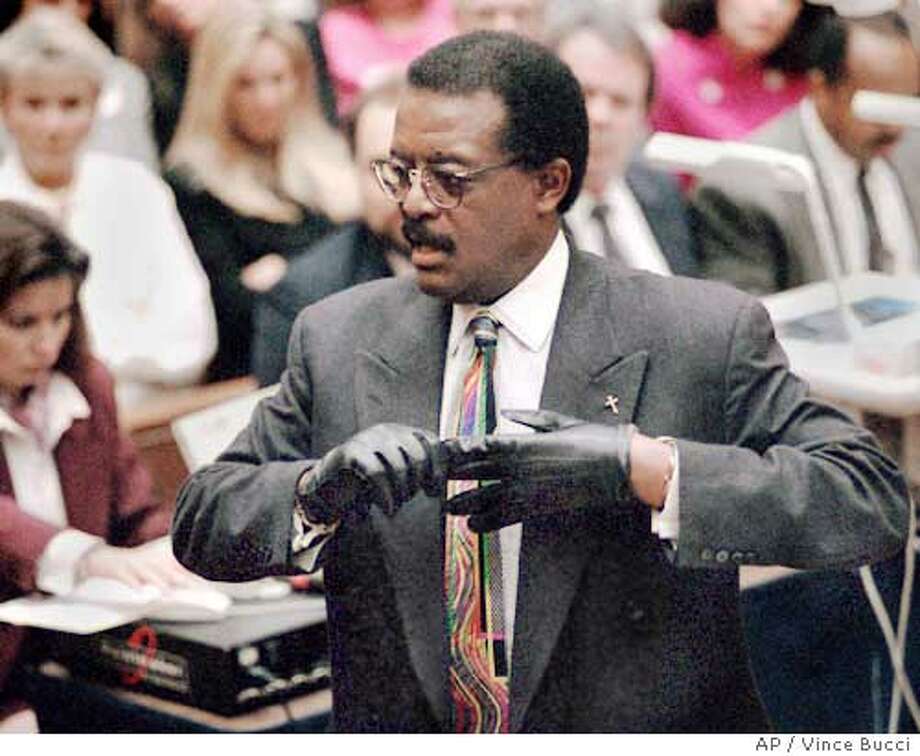



Some neat Art I found
I hope you like it!

The Marines charging in WWI
Anybody who has served can relate to this one
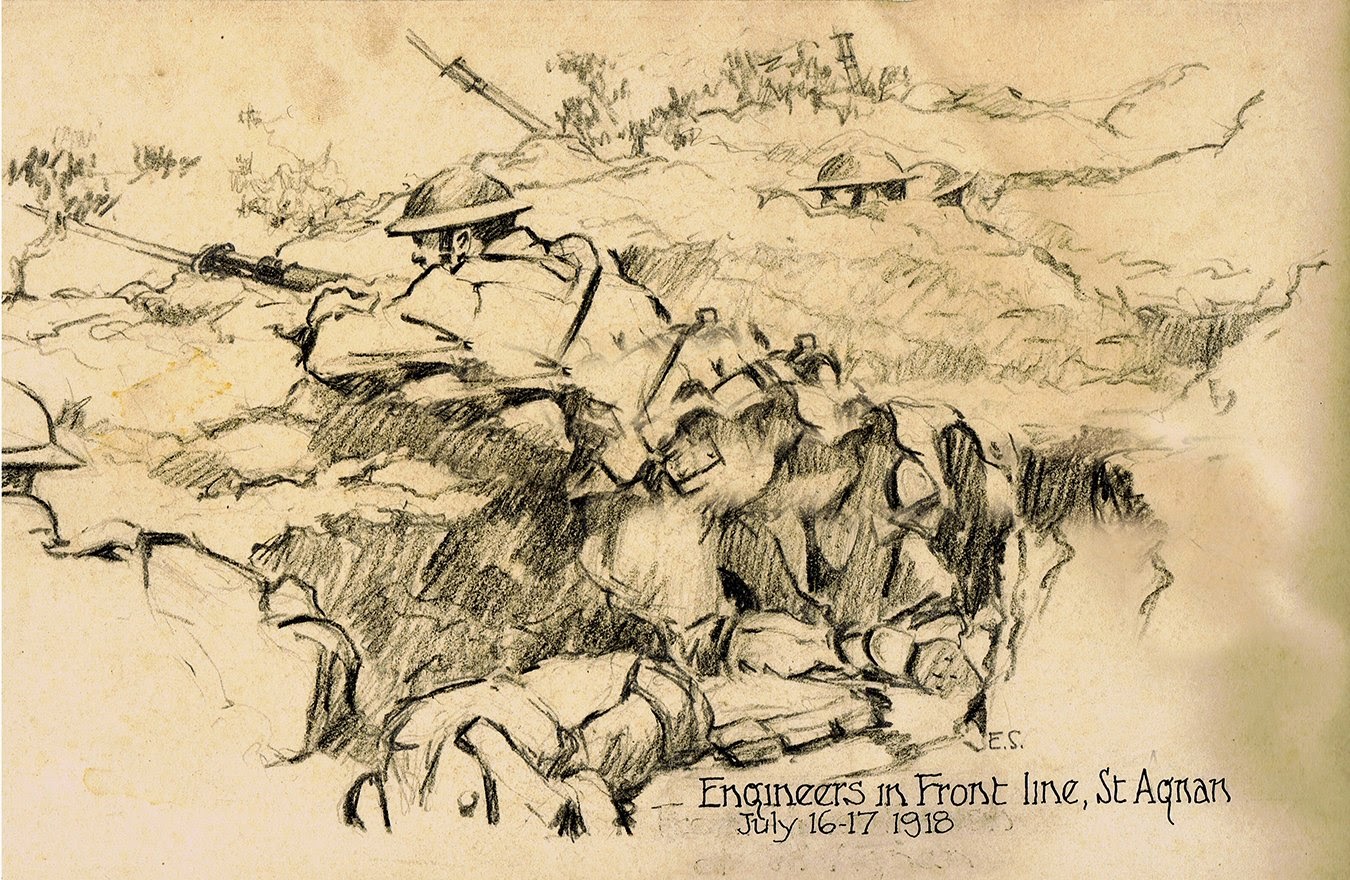







Now most Americans have probably never heard of this outfit. So here goes nothing! 
The Brits of the Empire Era were some pretty smart and tough cookies. Who had this knack of going into a area that they wanted to take over.
They then would beat the snot out of the locals in a pitched battle.Afterwards they then would enlist the survivors into a regiment, officered by them.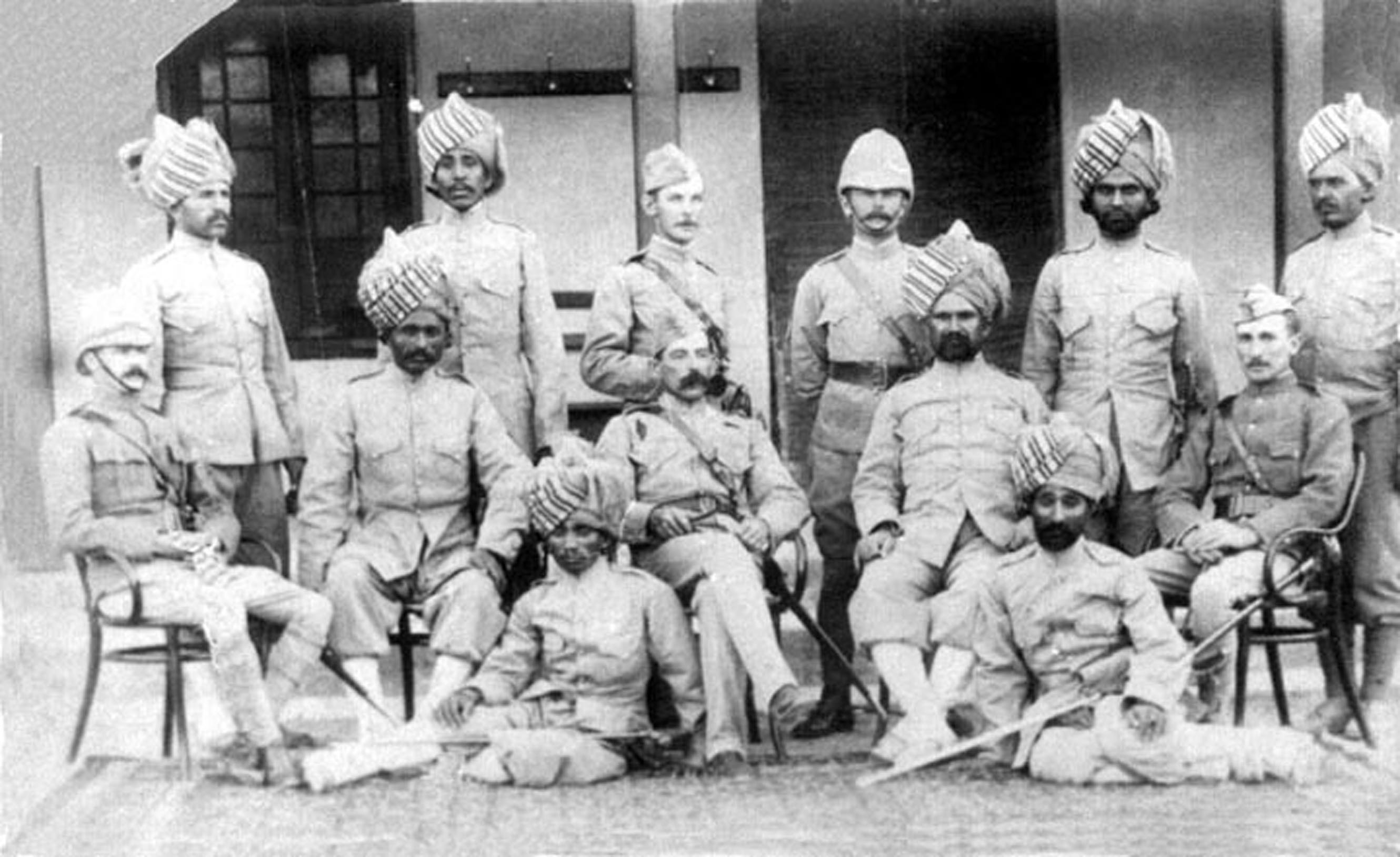
I am sure the locals figured that if you can not beat them then join them. Plus they would also get regular pay, uniforms and the prestige of the uniform of the Raj to boot.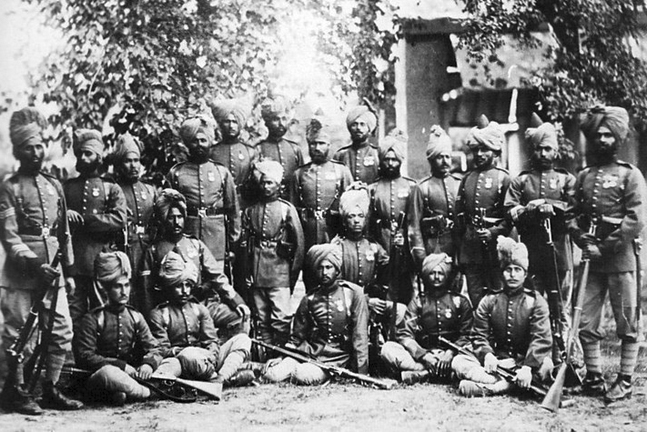
Then the Brits would led that unit to fight the next target of opportunity for the expanding Empire. Usually their neighbors, who the locals probably hated like sin.
Bottom line, The Brits get the locals to do their fighting for them for the most part. They also cost a hell of a lot less than a British Soldier. Since one did not have to ship them over from the UK or ship them home.
They also were use to the climate and were as a bonus pretty hard fighters in their own right. I call that some very clever thinking! So here is their story below!


Corps of Guides (India)
| Corps of Guides | |
|---|---|
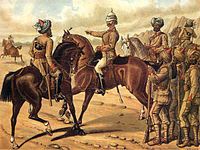 |
|
| Active | 1846–1922 |
| Country | Indian Empire |
| Branch | Army |
| Type | Joint Infantry-Cavalry |
| Part of | Bengal Army (to 1895) Punjab Command |
| Uniform | Drab; faced, 1859 drab, 1870 piped red, 1882 faced red, 1905 red velvet (officers) red cloth (soldiers), 1908 scarlet |
| Engagements | Punjab Mooltan Goojerat Delhi ALI MASJID 1879 KABUL 1878–80 AFGHANISTAN CHITRAL PUNJAB FRONTIER MALAKAND |
The Corps of Guides was a famous regiment of the British Indian Army which served in the North West Frontier and had the unique composition of being part Infantry and part Cavalry.
It evolved through the 20th century to become the Guides Cavalry.
It today exists as 2nd Battalion (The Guides) of the Frontier Force Regiment of the Pakistan Army
Contents
History
The brainchild of Sir Henry Lawrence, the Corps had Lt. Harry Lumsden as its commandant and W.S.R. Hodson (the Hodson of Hodson’s Horse) as second-in-command.
On 6 February 1847 Lumsden wrote to his father ” I have just been nominated to raise the corps of Guides. It will be the finest appointment in the country”.
A few months later, on 16 September 1847 Hodson wrote to his brother “..of my good fortune… I am to be the Second-in-Command with the Corps of Guides”.[2]
The Corps had modest beginnings. When it was raised at Kalu Khan, on the Yusufzai Plain, in the Peshawar Valley region by Lt. Lumsden in December 1846, it comprised just one troop of cavalry and two companies of infantry.
The first action was at Mughdara, in the Panitar Hills. Within two years, the small force of Guides had established a name for itself, under Lumsden, its founder, and Hodson .
When the Second Sikh War broke out in 1848, the unit was given authorisation for a three-fold increase in size, to six companies of infantry and three troops of cavalry.
The Guides maintained the quirky ‘cavalry and infantry combined in the same regiment’ format for many years, and even when split into two separate components, the name lingered in both elements.
The Corps of Guides became the garrison unit of a key post on the frontier, the new fort of (Hoti ~) Mardan. The building of the fort in 1854 was organised and supervised by Hodson[3] who had been promoted commandant of the regiment in 1852.[4]
In 1857 the unit was called urgently to help relieve the Siege of Delhi. In just over three weeks the Guides marched nearly six hundred miles during the hottest month of the year, crossing five great rivers and fighting four small actions.
The march coincided with the month of Ramadan meaning that the muslim soldiers in the force could neither eat nor drink during the hours of daylight.
On arrival at Delhi, the force of 600 Guides were almost immediately called upon to join the defence of the city. Men who had just completed a march of some 580 miles were thrown into a battle of such intensity that no fewer than 350 of the 600 became casualties within an hour of their arrival in Delhi.
The Corps of Guides was part of the Frontier Force brigade and developed a reputation of being an elite unit.
They were the first unit in the Indian or British Armies to dress in “khaki” uniform,[5]:537–539 first introduced in 1848. Typically, the Guides were often used in small detachments, usually supported by other Frontier Force troops.
The designations of the Corps of Guides changed over time as follows:
- The Corps of Guides (1846)
- The Corps of Guides, Punjab Irregular Force (1857)
- Corps of Guides, Punjab Frontier Force (1865)
- Queen’s Own Corps of Guides, Punjab Frontier Force (1876)
- Queen’s Own Corps of Guides (1901)
- Queen’s Own Corps of Guides (Lumsden’s) (1904)
- Queen Victoria’s Own Corps of Guides (Frontier Force) (Lumsden’s) (1911).[7]
In 1911 the cavalry and infantry components were designated as such. The cavalry then became, successively:-
- Queen Victoria’s Own Corps of Guides (Frontier Force) (Lumsden’s) Cavalry (1911)
- 10th Queen Victoria’s Own Corps Of Guides Cavalry (Frontier Force) (1922)
- The Guides Cavalry (10th Queen Victoria’s Own Frontier Force) (1927)[8]
and the infantry:-
- Queen Victoria’s Own Corps of Guides (Frontier Force) (Lumsden’s) Infantry (1911)
- 5th Bn (QVO Corps of Guides) 12th Frontier Force Regiment (1922)[9]
Post-World War II
In 1945, the 12th Frontier Force Regiment was renamed the Frontier Force Regiment and on independence and the partition of India it was allocated to Pakistan.
The cavalry regiment was also allocated to Pakistan and was renamed the Guides Cavalry (Frontier Force). In 1957, the Frontier Force Rifles and The Pathan Regiment were amalgamated with the Frontier Force Regiment to form a new Frontier Force Regiment.
The Guides battalion became the 2nd battalion of the new regiment.
The Guides wore scarlet facings on the collars and cuffs of their khaki uniforms from their establishment in 1846.[10]Accordingly both
The 10th Guides Cavalry (FF) and the 2nd Battalion (The Guides) of the Frontier Force Regiment of the Pakistan Army still wear red piping on the collars of their modern dress uniforms.
Literature
- The Guides are the subject of George John Younghusband‘s book, The story of the Guides, first published in March 1908.
- Rudyard Kipling‘s “The Ballad of East and West” is about the Guides.
- M.M. Kaye’s novel The Far Pavilions is about an officer in the Guides.
- Peter Stark Lumsden and George Robert Elsmie, Lumsden of the Guides: A Sketch of the Life of Lieut.-Gen. Sir Harry Burnett Lumsden, KCSI, CB., with Selections from His Correspondence and Occasional Papers (London: J. Murray, 1900; facsimile edition by BiblioLife, 2010)[11]
- Twelve years of a soldier’s life in India: being extracts from the letters of the late Major W. S. R. Hodson ed. by his brother, the Rev. George H. Hodson (London 1859) contains a number of references to its formation and accounts of the early years of the regiment under Lumsden and Hodson.
- Memoirs of General Sir Henry Dermot Daly, G.C.B., C.I.E. (1905) by Maj. H. Daly.
- The Leopard and the Cliff, a fictitious account of an incident in the North-West Frontier during the Third Anglo-Afghan War, was written by Wallace Breem, a Commissioned Officer in the Corps of Guides. Although not principally about the Guides it is contemporaneous and makes several references to them.
Founding figures

Queen’s Own Corps of Guides Memorial, Cavagnari’s Arch in Mardan
- Sir Harry Lumsden
- W.S.R. Hodson (the Hodson of Hodson’s Horse)
- G.N. Hardinge
- Dr. R. Lyell (MO)
- Frederick Battye
- Wigram Battye
- Sir Henry Daly, GCB, CIE
- Walter Hamilton, VC
- Surgeon A.H. Kelly (MO)
- Arthur Hammond, VC
- Daffadar Fateh Khan
- Rissaldar Fateh Khan
- Subedar Rasul Khan
- Subedar Dilwar Khan
Top 5 Weird WW2 German Weapons
M30 Luftwaffe drilling

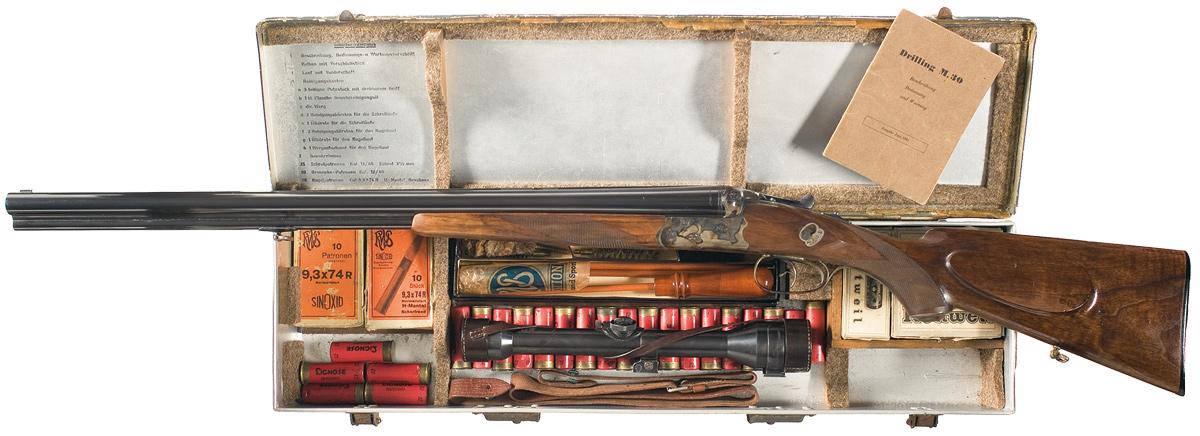
Say what you will about Old Fat Hermann Goering & he deserves every bit of it!


Rest in Hell old boy!
He did try and take care of his pilots. But as you can guess due to its cost and wartime shortages. Not too many of these excellent guns were issued out to the Grunts.
Most of them becoming booty that was brought home by the GI’s & Tommy’s of WWII.


| M30 Luftwaffe Drilling[1] | |
|---|---|
| Type | Combination rifle/shotgun |
| Place of origin | Nazi Germany |
| Service history | |
| Wars | World War II |
| Production history | |
| Manufacturer | Sauer & Sohn |
| Produced | 1941–1942 |
| No. built | 2,456 |
| Specifications | |
| Weight | 7.5 pounds |
| Length | 42″ |
| Barrel length | 25.625″ |
|
|
|
| Cartridge | 9.3x74mmR, 12 Gauge[2] |
| Barrels | 3 |
| Action | Blitz lock system |
| Feed system | Manually loaded |
| Sights | Fixed |
The M30 Luftwaffe drilling (“triple”) was a survival weapon issued to Luftwaffe pilots during World War II. It was intended to be used in the event that a pilot was shot down, for defense and for hunting game to stay alive until rescue.
For maximum versatility the M30 featured two 12 gauge shotgun barrels, and a 9.3x74mmR rifle barrel. They were manufactured by the German firm JP Sauer.
See also[edit]
References[edit]
- Jump up^ Kokalis, Peter (May 10, 2009). “Luftwaffe Drilling”. Shotgun News. pp. 26–30.
- Jump up^ Fjestad, S.P. (2009). Blue Book of Gun Values 2009. Blue Book Publications. p. 1318. ISBN 1-886768-87-0.
External links[edit]
- Sauer & Sohn M30 Drilling (Brazilian web site, with photos)
- “Luftwaffe Drilling and US M6 Survival Rifle at RIA”. Forgotten Weapons (YouTube). 2014-09-08.






